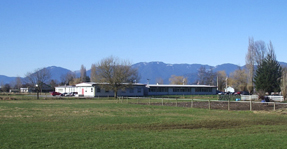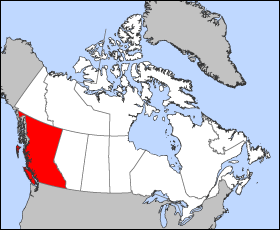External links
| Public post secondary | |
|---|---|
| Private post secondary | |
| Public K-12 |
|
| Private K-12 | |
| Defunct institutions | |
| South Island Distance Education School | |
|---|---|
| Address | |
4574 Wilkinson Rd. , , Canada | |
| Coordinates | 48°29′49″N123°23′40″W / 48.4969°N 123.3944°W |
| Information | |
| School type | Public, Distributed Learning |
| Founded | 1988 |
| School board | School District 63 Saanich |
| Superintendent | Dave Eberwein |
| Principal | Karen Flello |
| Staff | 60 |
| Grades | K-12 |
| Enrollment | 3500 (January 2018) |
| Website | sides |
| Last updated: August 10, 2016 | |
South Island Distance Education School (SIDES) [1] is a public, full-service, K-12 school, offering distributed learning courses to all students in British Columbia and is a member of School District 63 Saanich.
SIDES has over 3,500 students currently enrolled, from ages five to eighteen. About 20% of these students call SIDES their "school of record," meaning that they take most or all of their courses through the Distributed Learning program. SIDES's
Kindergarten to Grade 9 programs include the parents as an important part of the students' educational experience. Parents or other designated adults serve as "home facilitators" and partner with the SIDES teachers to deliver and support student learning.
SIDES's secondary program (Grades 10 - 12) is recognized as the equivalent of programs offered in neighborhood schools, with graduates attending post-secondary institutions throughout North America.
Adults who are residents of British Columbia and who have not yet graduated are eligible to complete their graduation requirements at SIDES (or any BC public school) free of tuition charges. Adults who are residents of British Columbia and who have already graduated from secondary school may take courses at SIDES to upgrade, however they are required to pay tuition fees if they choose to attend public secondary schools for this upgrading. If students are ordinarily residents of British Columbia, but are traveling or living abroad temporarily, they may take courses from anywhere in the world.
SIDES was established in 1988 as one of nine regional public "distance education" schools in British Columbia. At the time, the SIDES program was a paper-based program in which students worked in paper workbooks, sending assignments to the school via mail to be evaluated by teachers (known as "markers"). The program served students from grades K - 12 and worked with students only from the southern half of Vancouver Island and the nearby Gulf Islands.
Today, the program is almost entirely online (with some print resources). Students may join the school from anywhere in the province.
Distance education or distance learning is the education of students who may not always be physically present at a school. Traditionally, this usually involved correspondence courses wherein the student corresponded with the school via post. Today, it involves online education. A distance learning program can be completely distance learning, or a combination of distance learning and traditional classroom instruction. Massive open online courses (MOOCs), offering large-scale interactive participation and open access through the World Wide Web or other network technologies, are recent educational modes in distance education. A number of other terms are used roughly synonymously with distance education.

A student is primarily a person enrolled in a school or other educational institution who attends classes in a course to attain the appropriate level of mastery of a subject under the guidance of an instructor and who devotes time outside class to do whatever activities the instructor assigns that are necessary either for class preparation or to submit evidence of progress towards that mastery. In the broader sense, a student is anyone who applies themselves to the intensive intellectual engagement with some matter necessary to master it as part of some practical affair in which such mastery is basic or decisive.

Education in Canada is for the most part provided publicly, funded and overseen by federal, provincial, and local governments. Education is within provincial jurisdiction and the curriculum is overseen by the province. Education in Canada is generally divided into primary education, followed by secondary education and post-secondary. Within the provinces under the ministry of education, there are district school boards administering the educational programs.
Free education is education funded through government spending or charitable organizations rather than tuition funding. Many models of free higher education have been proposed. Primary school and other comprehensive or compulsory education is free in many countries, including post-graduate studies in the Nordic countries. The Article 13 of International Covenant on Economic, Social and Cultural Rights ensures the right to free education at primary education and progressive introduction of it at secondary and higher education as the right to education.
School District No. 43 (Coquitlam) or SD43 is one of the sixty school districts in British Columbia. The district is the third largest in British Columbia with 45 elementary schools, 14 middle schools, and 11 secondary schools. School District No. 43 (Coquitlam) serves the Tri-Cities, including the cities of Coquitlam, Port Coquitlam, Port Moody, and the villages of Anmore and Belcarra. The school district covers an area of 120 square kilometres and serves a total combined population of 210,390 residents. It has over 4,000 full-time and part-time employees. The school district has one of the highest graduation rates in the province, with 91.9% of students graduating in the 2013/14 school year.

Fraser Valley Distance Education School (FVDES) is one of the largest distance education schools in British Columbia, Canada. It offers both online and paper-based distance learning from kindergarten to grade 12. FVDES's students include both school age and adult learners. Most live in the Lower Mainland of B.C., but a growing number live in other areas of the province or overseas. FVDES is a publicly funded school that follows the British Columbia school curriculum and offers full "Dogwood" certification upon graduation.

Florida Virtual School (FLVS) was founded in 1997 as the first statewide Internet-based public high school in the United States. In 2000, FLVS was established as an independent educational entity by the Florida Legislature. Recognized as its own district within the state, it provides online instruction to Florida students in Kindergarten through 12th grade. According to its website, "FLVS is part of the Florida public education system and serves students in all 67 Florida districts. FLVS also serves students, schools, and districts around the nation through tuition-based instruction, curriculum provision, and training." As a public school, its funding is tied directly to student performance.

The Vancouver Learning Network is a public distance education secondary school headquartered in Vancouver, British Columbia, Canada. It is part of the Vancouver School Board.
School District 68 Nanaimo-Ladysmith is a school district on central Vancouver Island in British Columbia. This includes the major centres of Nanaimo and Ladysmith. It is also covers the surrounding communities and the adjacent northern Gulf Islands.
Following independence from the Soviet Union, a major economic depression cut "public financing" for education in Kazakhstan, "which dropped from 6% of gross domestic product in 1991 to about 3% in 1994, before rising to 4% in 1999." Elementary- and secondary-school teachers remain badly underpaid; in 1993 more than 30,000 teachers left education, many of them to seek more lucrative employment.
The Open Learning Agency (OLA) was a Crown Agency of the province of British Columbia, Canada. Its primary function is the management of the Knowledge Network, a public television station in British Columbia, although it once played a larger role in education and a university function, before being scaled back by the provincial government in 2004.

Higher education in Quebec differs from the education system of other provinces in Canada. Instead of entering university or college directly from high school, students in Quebec leave secondary school after Grade 11, and enter post-secondary studies at the college level, as a prerequisite to university. Although both public colleges (CEGEPs) and private colleges exist, both are colloquially termed CEGEPs. This level of post-secondary education allows students to choose either a vocational path or a more academic path.

Newfoundland and Labrador has had the same growing pains as other provinces in developing its own form of education and now boasts a very strong, although relatively small, system. The direction of Newfoundland and Labrador's policy has evolved rapidly since the late 1990s, with increased funding, participation rates, accessibility and transferability. Many of the directives the government has been acting upon in the past 10 years have been a result of recommendations that stemmed from a 2005 white paper: Foundation for Success: White Paper on Public Post-Secondary Education. It set the course for furthering the strategic directives of the provincial post-secondary education sector. Some of its recommendations aimed to:

Higher education in Alberta refers to the post secondary education system for the province of Alberta. The Ministry of Advanced Education in Alberta oversees educational delivery through universities, publicly funded colleges, technical institutions, and private colleges. These institutions offer a variety of academic and vocational pursuits. Students have access to post-secondary options through most regions of Alberta, and a developed articulation system allows for increased student mobility.

Higher education in Prince Edward Island refers to education provided by higher education institutions in the Canadian province of Prince Edward Island. In Canada, education is the responsibility of the provinces and there is no Canadian federal ministry governing education. Prince Edward Island has one university, the University of Prince Edward Island authorized to grant degrees, and two community colleges, Holland College, which operates centres across the province, and Collège de l'Île, which offers post secondary education in French. The governing body for higher education in Prince Edward Island is the Department of Innovation and Advanced Learning, headed by the Minister of Innovation and Advanced Learning, the Honourable Allen Roach.

Higher education in British Columbia is delivered by 25 publicly funded institutions that are composed of eleven universities, eleven colleges, and three institutes. This is in addition to three private universities, five private colleges, and six theological colleges. There are also an extensive number of private career institutes and colleges.

Higher education in Nunavut allows residents of this Canadian Arctic territory access to specialized training provided at post-secondary institutions. There are some unique challenges faced by students wishing to pursue advanced training in Nunavut, a vast territory stretching across Arctic Canada from Hudsons Bay to the north pole. The territory was split from the Northwest Territories in 1999, following a successful plebiscite which affirmed Inuit desires to establish an independent political jurisdiction. Covering one-fifth of Canada’s area and over 60% of its coastlines, the territory had a population of 31,153 in 2010.
There are numerous elementary, secondary, and higher institutions of learning in the U.S. state of Pennsylvania, which is home to 500 public school districts, thousands of private schools, many publicly funded colleges and universities, and over 100 private institutions of higher education.
North Coast Distance Education at www.ncdes.ca is a public distance education program in Northern British Columbia offering distributed learning courses to students in BC. NCDE is a member of Learn Now BC and BC Learning Network
SCIDES or South Central Interior Distance Education School is a distance education school which teaches elementary, middle, and high school programs online. SCIDES also provides programs for both graduated adults (upgrading) and non-graduated adults. It is an accredited public school, and as such is tuition free. SCIDES offers over 150 courses, all of which are authorized by the BC Ministry of Education and taught by BC certified teachers. SCIDES is open 12 months of the year and offers continuous enrollment. SCIDES is able to provide cross-enrollment for students in brick-and-mortar schools or full-time school program options. SCIDES headquarters is located in Merritt, British Columbia, and is part of School District 58.